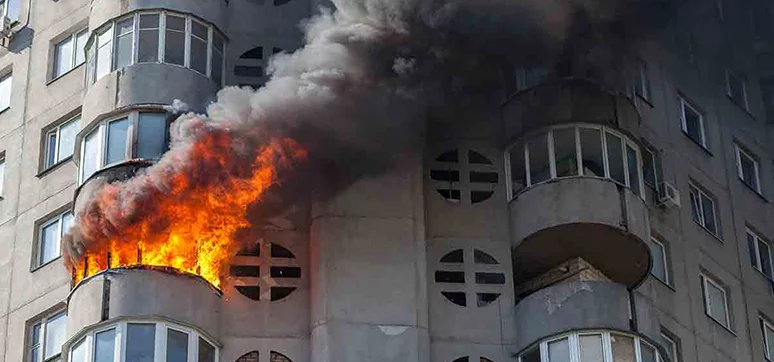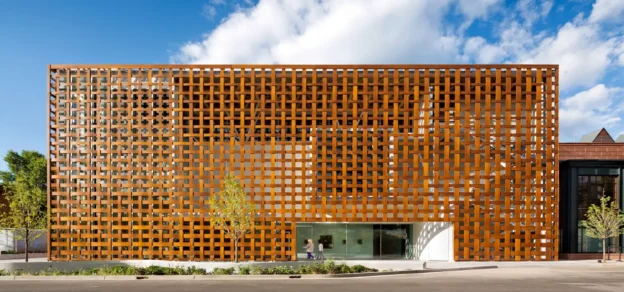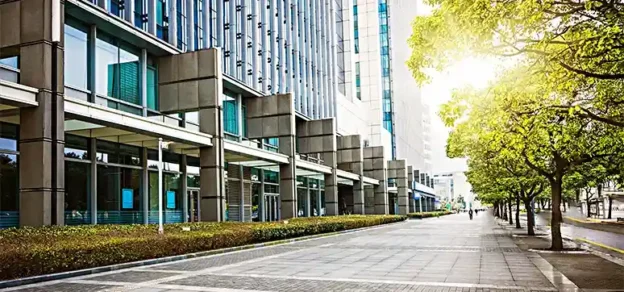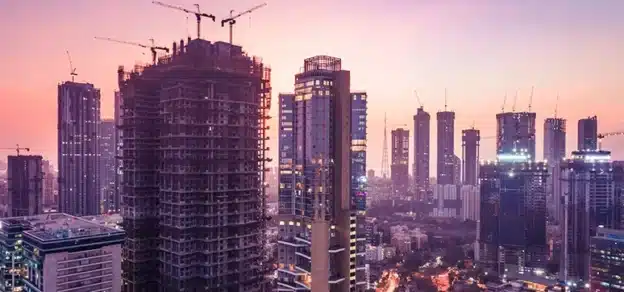Façade is one of the most susceptible elements of building design. The majority of the population, being ignorant about the performance of the material, often fail to understand the veracity that the façade design plays, especially in controlling or propagating the spread of fire. With more emphasis on aesthetics, energy efficiency, cost factor, etc., fire safety has always been kept under the radar. However, keeping in view the present market trends, this has gone beyond just the aesthetic part and plays a more prominent role in light conveyance, acoustics execution, and effectiveness.
The scenario has become more complex with the unstoppable mushrooming of high-rise buildings which pose a greater fire hazard. Though there are numerous fire safety-related codes and standards, in India these are scarcely followed. When it comes to façades, it is mostly influenced by the pure considerations of alluring appearance and pricing, and is yet to hit the nail on the head in terms of fire safety norms and testing methods.
There is a lack of awareness about the characteristics of façade materials, such as combustibility, smoke release, toxicity, ignitability, etc. that contribute to massive fire proliferation. Therefore, an active involvement of industry experts from design to construction can be of significance in deciding the appropriate material for the façade along with their correct usage.
It is much more than just the precaution and more about unanimous acceptance of the fact that any potential fire hazards can only be combatted when façade systems, materials and testing are given due importance. Here, the focus should be on the holistic approach towards analyzing the performance of façade materials, aspects of façade design for fire safety, fire testing of façade materials along with the importance of compartmentalisation and much more.
Important Aspects of Facade Designs For Fire Safety

There are primarily two methods to plan a building façade for fire safety. One is to detect and act (active fire protection) using detectors, annunciators, sprinklers, etc. While the second method is to contain and restrict fire in a given location (passive fire protection). Here, reaction and resistance to fire properties are utilised to contain or create a compartment, which helps in minimising damage and also in evacuation to save lives. There are plenty of important elements in architecture and façade which are key components, and these should be designed keeping in mind the aesthetical part of it as well as other safety measures to endure any adverse situation; both natural or man-made.
Cladding and façade play the most prominent role in fire safety because these are the main reasons for fire spread. Correct selection of material and system design are the two key elements that form the basis of fire safety of a façade system. Engineers planning firesafe cladding framework need to know the fire properties of the material being utilised and their key response to fire like ignitability, combustibility, fire spread, and responses of droplets and smoke. This essential information is utilised to plan a framework and the net fire properties when the given materials are contiguous to one another. Façade must not propagate fire and also not let the fire or heat travel from one area to another, or should not disintegrate in the presence of fire for a reasonable amount of time.
The enactment expected out of most building materials from a fire safety standpoint is its resistance to fire and not the combustibility alone. The resistance time the material provides is calculated towards the dissolution of the material, the rate of fire spread, and the essential escape time it gives the occupants before it is out of control. It should be able to bear a minimum of 30 minutes to two hours of fire resistance, depending on the distance from the source of fire or required resistance.
Petrochemical-based materials like aluminium composite panels, PU foam metal panels, insulations, etc. can propagate fire. The façade material can be further classified based on certain lab assessments as ‘A’ class and ‘B’ class and their subclasses. ‘A’ class, being the highest amongst the non-combustible fire safe materials, comes a bit costly making it hard to afford for large-scale project formats. However, where the fireproof enclosure is absolutely essential, the specifications should be prerequisite to adhere to ‘A’ class.

Keeping in view the objective of maximum fire resistance, all materials used in the construction has to be fire safe and not the façade. Additionally, as mentioned earlier, the structure must be able to retain its integrity for a minimum of 30 minutes, as per the NFPA 285 code for fire resistance of façades. Moreover, smoke vents are an important part of the facades, which primarily include aluminium, glass, sealant, gaskets along with the hardware, and the automation kit might also be vulnerable to fire. Therefore, these also should be tested basis global standards like the EN 12101 Part 2 and CE marked which ensures the holistic performance of the vent and not just the builtup hardware.
In this scenario, the entire vent is placed in a fire test chamber as high as 300°C, where post 5 minutes, the vent is expected to open fully within 60 seconds and remain open for a minimum period specified. Only thereafter this can be passed into the system testing. Considering the various vulnerable points while planning a fire safety system, it is always advisable to test one or more large scale fire mock-ups, to validate the effectiveness of the system design, planned to be implemented at the site.
Material Selection
Material selection and system design being the two key elements, it is necessary to identify the accurate cladding and façade material to mitigate the fire hazards as much as possible. These materials also contribute to choosing the accurate cladding framework, which is fundamental while assessing the environmental effect of the structure in future settings. A couple of different elements that should be considered as fundamental for the framework ought to be – their inner and outside conditions, toughness, nearby setting, arranging prerequisites, openness, buildability, appearance, accessibility, support necessities just as the auxiliary necessities. Structural wall elements play an instrumental role between the wall and cladding. If due to the lack of effective planning, there is a gap in the structure then in case of a fire, this might draw the hot air up, elevate fire, and spread to the head of cladding. Amongst preferable materials, brick has magnificent fire resistance along with fibre concrete/steel weatherboards.

In addition, aluminium and reconstituted timber items have great resistance as well, where the timber weatherboards and pressed wood sheets can also act as a shield to fire. Fire will be spread by the cladding if the centre is fire-prone. External wall systems frameworks comprise of essentially three things – outside cladding with air cavity behind, persistent protection (CI), and water/climate resistive hindrances (WRB).
Here, the combustibility of each one of these segments can severely impact the fire execution of the entire lot. The final segment is the climate/water-resistive obstruction (WRB) introduced over the outside sheathing. It is utilized to forestall dampness harm to the structure and assists in keeping up the comfort level inside the structures by controlling relative moistness. In terms of cladding as well, it is advised not to advance with any combustible element as it might heighten the fire risk status through ACPs along with highly flammable polymer core.
Precautions While Designing
Few precautions are advisable while building the façade to control fire spreading which can be done through applying fire stops and smoke seal. There is little point in having a fire evaluated segment if the division is intended to compartmentalize the fire does exclude fire stopping. On the off chance that if space isn’t accurately fixed, it can prompt the fire spreading, smoke, and poisonous gases getting away. Time is the key substance with regards to hindering the spread of fire and fire-stopping when introduced close by other aloof assurances.
In this situation, firewalls can repress the spread of fire for as long as four hours, permitting individuals to leave the structure and the fire administrations to show up. Depending upon the sort of fire anticipation technique required, the scope of fire-stopping should be utilized at its best. The essential part of this passive fire protection is a fire stopper, which is why it is so important that it is installed by trained professionals.
The Path Ahead
In India, there are innumerable fire safety-related codes and standards which are hardly followed. In terms of facades as well, the primary importance is always given to the pure considerations of alluring appearance and pricing. In building structure, fire safety is dependent on the choice of each and every material that is identified and applied in construction. Facade design needs to be done in a manner that it does not allow the fire to spread from one compartment to another.
Its design has a contradictory impact on buildings, as these can be significant in case of regular usage, but at the same time can also be hazardous and unsafe if combustible materials are being used. We can say that the materials used can be due to ignorance or value engineering (VE) options as the façade cost is considered at the end of the project. Therefore, it is always important to step back, review and then move forward while designing a façade and focus on the fire preparedness it can offer, in order to achieve a safe and holistic experience.














